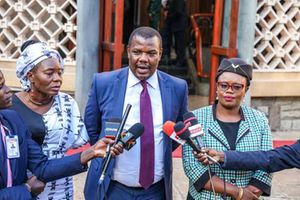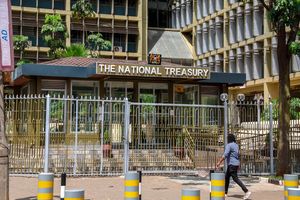Battle to save Embobut Forest must be won

A section of houses ablaze on 16 January 2014 in Kamoyokwo village in Embobut Forest, Elgeyo Marakwet County. The houses belonging to the Sengwer community were burnt by the Kenya Forest Service to compel forest dwellers to vacate the forest land. PHOTO: Copperfield Lagat /NATION
What you need to know:
- The failed 20 evictions are evidence of the dangers of politics of convenience and official lethargy.
- The task force established that most of the squatters were opportunists with land elsewhere
- Rains have become erratic and, with water for irrigation becoming scarce, the horticultural industry in the valley is under threat.
The recent eviction of squatters from Embobut Forest in Elgeyo Marakwet County has elicited condemnation. The tragedy that is the near-decimation of a critical water tower has been unfolding for decades now and the failed 20 evictions are evidence of the dangers of politics of convenience and official lethargy.
Embobut Forest measures 21,933.9 hectares, representing 13.4 per cent of the total area of Marakwet East sub-county. However, by 2008, 16,000ha had been cleared by illegal squatters, loggers, and charcoal burners, leading to massive soil erosion, siltation of rivers, declining water levels, and the attendant climate change.
Conscious of past failed evictions, the government appointed the Embobut forest restoration task force in 2009 to provide a roadmap for conservation and relocation of squatters with a view to resolving the encroachment and destruction of the forest. The task force was a follow-up of a district consultative forum held on 4 April, 2009, which resolved that illegal squatters were to be moved or evicted from the forest to save the catchment, a critical part of the Cherangani water tower.
OPPORTUNISTS
The task force established that most of the squatters were opportunists with land elsewhere and did not turn up for vetting — the number of squatters was estimated at over 20,000 but after vetting, only about 3,000 were found to be genuine and in three groups: Permit holders, forest dwellers (Sengwer/Kimala), and landslide victims. It was recommended that 2,964 genuine squatters be resettled elsewhere.
Although the task force identified and listed those to be compensated, politicians manipulated the list to benefit their cronies and relatives, in the process excluding the genuine squatters.
For years now, residents of Marakwet East have been calling on the government to stop the senseless destruction of the forest, which has manifested in dwindling water volumes in the region’s seven rivers, namely Arror, Embomon, Embobut, Embolot, and Muruny, which drain into Lake Turkana through the Kerio and Turkwel rivers, and Moiben and Chepkaitit rivers, which drain into Lake Victoria and ultimately River Nile through Nzoia River.
TRAMPLING ON RIGHTS
Rains have become erratic and, with water for irrigation becoming scarce, the horticultural industry in the valley is under threat. And so are the livelihoods of residents. The “rights” of a few selfish squatters are no excuse for trampling on the rights of millions of people who depend on the resources of Embobut Forest. For the benefit of present and future generations, there should be no illegal settlers in the forest.
As part of efforts to restore this vital resource, the government must comprehensively address the urgent and complex issues that will determine the fate of forests, namely climate change, conservation objectives and sustainable development needs, and the growing demand for affordable energy.
A community approach to the conservation of natural resource rests on three assumptions: That residents are better placed to conserve the resources, that people will conserve a resource only if its benefits exceed the costs of conservation, and that people will conserve a resource that is linked directly to the quality of their life.
Mr Cheboi is a resident of Marakwet East. ([email protected])





